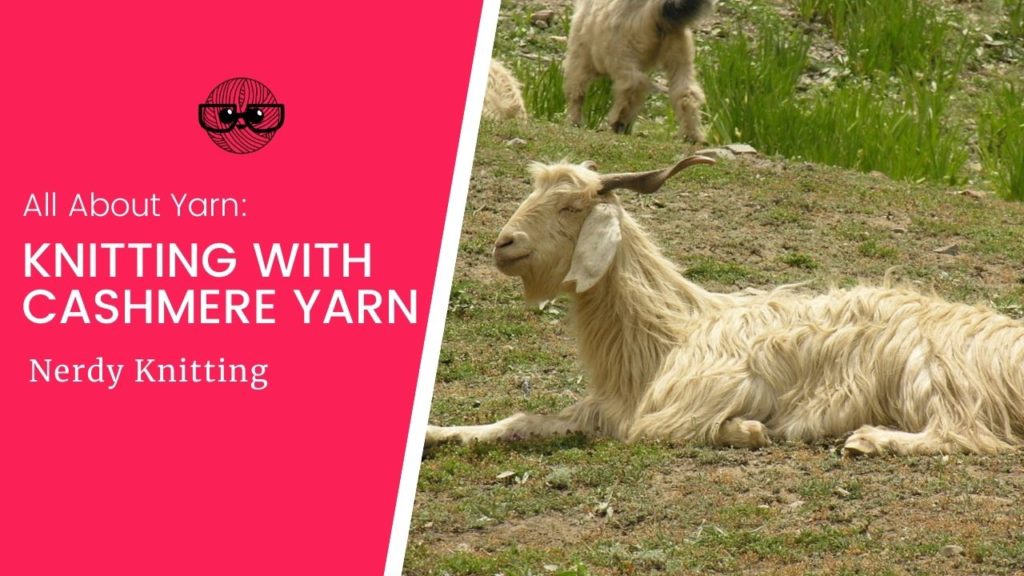Cashmere is a luxurious knitting fiber that can feel decadent to knit with. But, before you purchase that expensive cashmere yarn, there are some facts you should know so you’ll enjoy knitting with cashmere, have a finished project you can be proud of, and know how to properly care for that beautiful finished garment.
In this article we’ll look at some of the important things you need to know about knitting cashmere yarn:
- A Look at Cashmere
- Properties of Cashmere Yarn
- Knitting with Cashmere Yarn
- Choosing Knitting Patterns
- Caring for Finished Projects
- Buying Cashmere Yarns
- More Questions about Knitting Cashmere Yarn
Let’s take a closer look at cashmere yarn – so you’ll know when it’s the right choice for your next knitting project.
Some links below are affiliate links. If you click through and make a purchase I may receive a small commission at no extra cost to you. See the disclosure policy for more information.
A Look at Cashmere
Knitting fibers can be divided into four basic categories – animal fibers (like wool, silk, and alpaca), plant fibers (like cotton and linen), biosynthetic fibers (like rayon and bamboo), and synthetic fibers (like acrylic and nylon). Cashmere falls within the animal fibers category because the fiber comes from the Kashmir goat. It falls within the ‘specialty wool’ category because it’s considered ‘wool’ but it doesn’t come from sheep.
This distinctive category of wool comes from the Kashmir (or Pashmina) goat that is native to the Himalayas (but can now be found in various places). The Kashmir goat has two coats – the coarse outer coat, called the ‘beard,’ and the finer undercoat. Both of these coats are combed from the goats once a year and the fibers are separated. Each goat produces just a few ounces of the cherished undercoat each year – which is why this fiber is so expensive. Colors range from a naturally light tan to shades of brown and are usually bleached before dyeing.
These hairs are very short (1 to 3 1/2 inches long) and very fine. The undercoat of the Kashmir goat has fewer scales than sheep’s wool which gives it a silky feel but it also makes it more difficult to spin into yarn that wears well. While you can find 100% cashmere commercially available yarns, it’s more likely to be blended with other fibers that are easier to spin into yarn.

Properties of Cashmere Yarn
Cashmere is a luxury yarn for a reason – because it’s just so nice to knit with and it feels wonderful in your hands. And, there are some other advantages to using this beautiful fiber (see the list below).
But sometimes you may want to skip the cashmere yarn. It has certain disadvantages that you should know before you start knitting (see the second list below). You certainly don’t want to begin a project only to discover that your expensive, beautiful yarn just isn’t right for the project you’ve chosen.
Advantages of Cashmere
There are plenty of reasons to choose cashmere. Here are some of the advantages of this beautiful fiber:
- extremely soft
- resilient
- warmer than sheep’s wool
- receptive to dye
Disadvantages of Cashmere
While cashmere has some clear advantages that make it a beautiful fiber to knit with, there are also some drawbacks to using this yarn. Here are some of the reasons you may not want to choose cashmere:
- weaker than sheep’s wool
- prone to pilling
- expensive
Cashmere is obviously expensive because the Kashmir goats produce such small amounts of their beautifully soft undercoat. Because of the expensive nature and its delicacy, you’ll often find cashmere blended with other fibers. This reduces its cost, gives it some additional strength, as well as adding some benefits to the blend – cashmere brings its beautiful softness and warmth.
Knitting with Cashmere Yarn
Knitting with cashmere yarn is usually a dream – it’s so soft and luscious in the hands (of course, this is entirely dependent on the particular yarn or blend you’re using).
Because it’s a weak (making it prone to pilling) and expensive fiber, it’s best used in a blend with other fiber types – a wool and cashmere blend is a great choice for a sweater. But you aren’t limited to that. 100% cashmere yarns can still be used for smaller accessories that won’t get as much wear and tear. Things like cowls and hats can be beautiful when knit with 100% cashmere.
Discover the Confidence You Need to Fix Your Knitting Mistakes
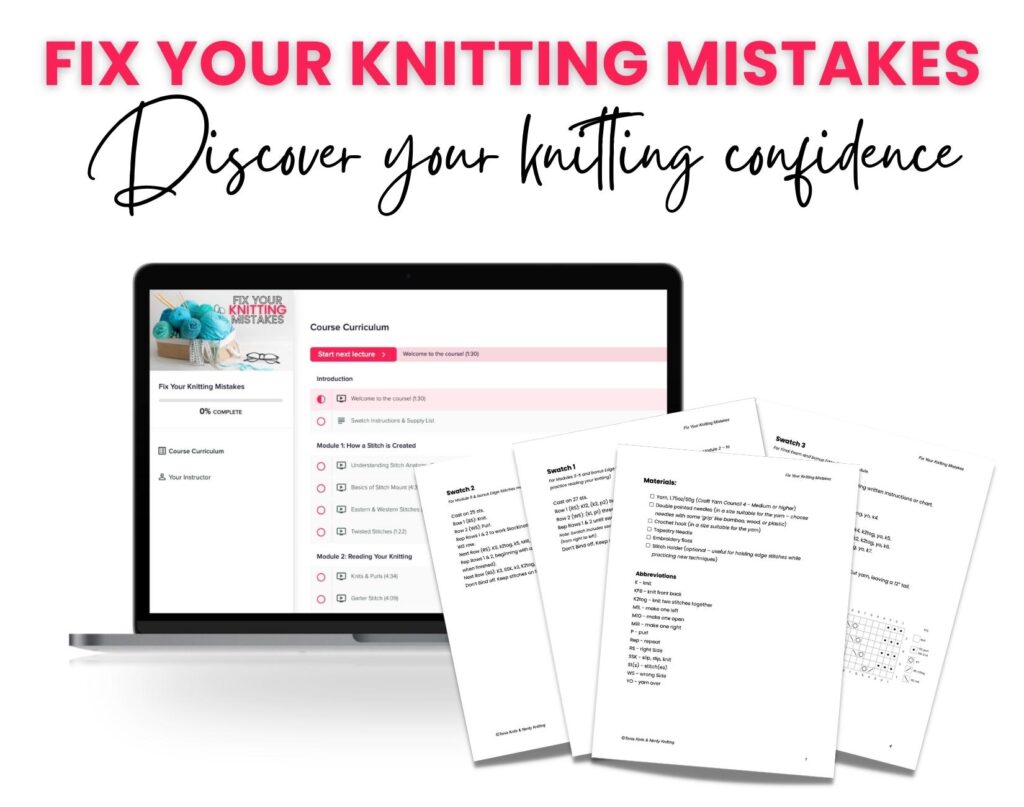
By the end of this six-part self-paced course, you’ll be able to read your knitting, recognize a variety of knitting mistakes, and understand how to fix them.
Choosing Knitting Patterns
There are so many knitting patterns that would benefit from using a cashmere yarn or blend. Anything that’s close to the face or skin – like cowls, hats, and mittens are a great choice for 100% cashmere yarns (small projects also cost less – making an expensive yarn a splurge-worthy choice). The same goes for shawls and wraps, which are absolutely luxurious in 100% cashmere.
But because of it’s weakness and tendency to pill, 100% cashmere isn’t a great choice for sweaters or cardigans – especially those that get a lot of wear. Instead, look for a blend where 5-15% of the content is cashmere blended with wool or a wool and silk blend. You’ll get the luxury and softness of the cashmere without the pilling.
There are plenty of blends today that add just a touch of cashmere in a machine-washable yarn – so you can even knit projects that may require more wear, tear, and care. Baby items can be lovely in some of these blends – the yarns are soft enough for baby’s skin but still easy to care for as well.
But there are definitely times you’ll want to avoid cashmere. It’s not a good idea when it’s something that will be going through a lot of wear and tear or hard use – like hand cloths and dishcloths or kids clothes. It’s a delicate fiber that’s best used in accessories or blended with other fibers to give it additional strength.
Caring for Finished Projects
Cashmere needs to be treated gently. In most cases, hand washing and drying flat on a blocking mat or towel are your best choices. But you can also find cashmere blended with other fibers that change how they need to be treated (you can even find cashmere in some machine-washable blends).
The best option is always hand washing but it really depends on the other fibers that are blended with the cashmere (superwash wool actually needs the washing and drying to maintain it’s shape). It’s always a good idea to read the yarn label for your particular yarn and follow the care recommendations.
When you are washing by hand, be sure to gather the whole garment in your hands – cashmere is a fragile fiber. Don’t let the wet garment stretch or sag.
If your cashmere garment just needs a quick refresh, a hand-held garment steamer or a clothes iron set to medium can be used to freshen up the garment. Just place the garment on a flat surface and run the steamer slowly over the garment. If you’re using a clothes iron – never press the iron on the garment – just use the steam feature, holding the iron about an inch or so away from the fabric.
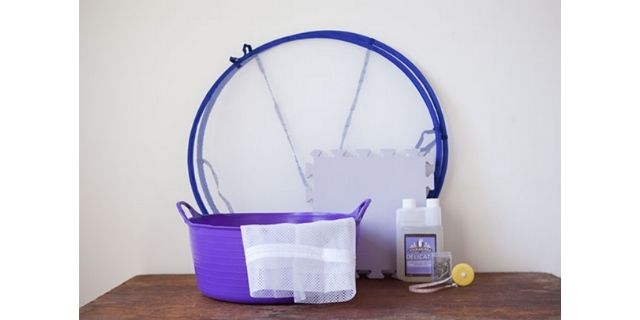
How to Block Cashmere Knits
Hand washing and blocking is the best choice for most cashmere yarns and blends (unless the yarn label gives specific instructions for machine washing).
Hand washing cashmere yarns: Fill a small basin with cool to lukewarm water and a little mild detergent. Submerge the garment in the liquid, carefully using your fingers to dislodge any stains. Don’t agitate the garment too much. Let the garment soak for a few minutes (up to about 30 minutes, if you want).
To rinse the garment, hold it to one side of the basin as you drain the water and add fresh water. When you’re ready to dry the garment, gather the whole garment in your hands, lifting it gently from the water and carefully squeezing out the water. Place the garment on a towel, roll it up, and press out the excess water.
Wet-blocking cashmere yarns: After washing and pressing out the excess water with a towel, place the garment on a dry towel or mesh sweater dryer and place it in its final shape, being careful to lightly stretch any lace or other openwork designs to showcase them.
Spray blocking cashmere yarns: If you have a project that is very fragile, spray blocking may be a better choice. Place the garment on a mat or towel, adjusting it to its finished dimensions, and pinning the garment if needed. Using a spray bottle, gently mist the garment with water until it’s wet to the touch. Let it to dry completely.
Buying Cashmere yarns
Cashmere yarn is available in a variety of ways. You can find 100% cashmere yarns (which should be reserved for accessories or items that won’t see heavy use). But cashmere is a star when it’s blended with wool and other fibers (a wool, cashmere, and silk blend is just wonderful to knit with).
You’ll find a selection of yarns listed here – 100% cashmere, cashmere and wool blends, cashmere blended with other fibers like cotton and linen, and even some options for machine-washable yarns that include cashmere.
100% Cashmere

For those ultra-luxe accessories or items that won’t see hard use, a 100% cashmere yarn is a splurge-worthy choice. Give one of these 100% cashmere yarns a try:
- Debbie Bliss Luna
- Lang Yarns Cashmere Premium – also available in various yarn weights
- Rowan Pure Cashmere
Cashmere & Wool Blends
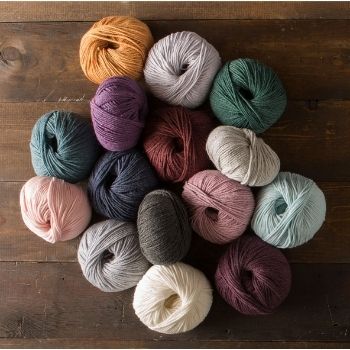
Cashmere is often blended with sheep’s wool and other fibers – it adds a touch of softness and luxury while the other fibers offset the inherent weakness of cashmere.
One commonly seen blend is a wool, silk, and cashmere blend – you really can’t beat the beauty of that combination! If you want a beautiful sweater or shawl, one of these yarns would be a great choice:
- Knit Picks Capra DK (Merino wool & cashmere)
- Knit Picks Aristo (Merino wool, silk & cashmere)
- Willow & Lark Nest (Merino wool, tencel & cashmere)
- Sirdar Cashmere Merino Silk DK (Merino wool, silk & cashmere)
- Malabrigo Caprino (Merino wool & cashmere)
- Rowan Finest Limited Edition (wool, alpaca & cashmere)
Other Cashmere Blends
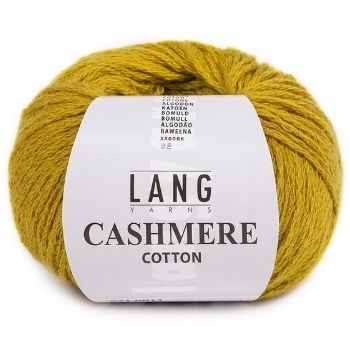
While cashmere blended with wool is a classic pairing, you can find cashmere blended with other fibers as well. A bonus is that some of these blends produce a yarn that is machine washable. Here are a few intriguing yarn blends that would be nice for a variety of projects:
- Jade Sapphire Sylph (cashmere & linen)
- Lang Yarns Cashmere Cotton (cashmere & cotton)
- Rowan Cotton Cashmere (cashmere & cotton)
- Rowan Sultano (silk, mohair & cashmere)
- Plymouth Yarn Cashmere de Cotone (cotton & cashmere)
- The Fibre Co. Road to China Light (baby alpaca, silk, camel & cashmere)
- Rico Essentials Cotton Silk Cashmere DK (cotton, silk & cashmere)
Machine-Washable Cashmere Blends
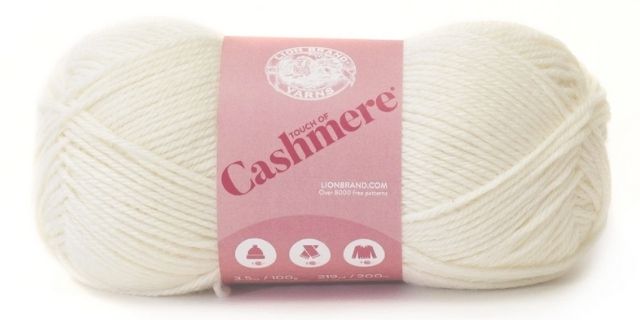
Sometimes you want the best of both worlds – that soft touch of cashmere but the easy-care of a machine washable (and often machine dry-able) yarn. Read the labels though – some of these need to be washed on the delicate cycle.
- Lion Brand Touch of Cashmere (acrylic & cashmere)
- Knit Picks Capretta Superwash (Superwash Merino wool, cashmere & nylon)
- Debbie Bliss Baby Cashmerino (wool, acrylic & cashmere) – available in other weights as well
- Sirdar Snuggly Baby Cashmere Merino DK (Merino wool, acrylic & cashmere)
- Rowan Baby Cashsoft Merino (Merino wool, acrylic & cashmere)
More Questions About Cashmere
While we’ve covered a lot of information, you may just be looking for a quick answer to your question. Here are a few common questions that knitters often have about knitting with cashmere yarn.
What can I knit with cashmere yarn?
100% cashmere should be reserved for small accessories that will be treated gently. Things like cowls, shawls, lightweight scarves, hats, and mittens are all good choices for luxurious cashmere yarns.
Why is cashmere so expensive?
Cashmere comes from the soft undercoat of the Kashmir goat which is native to the Himalayan mountains. These goats are combed once a year and the fiber is collected and sorted. The soft undercoat only accounts for a few ounces of the collected fiber from each goat. Because of it’s rarity as well as it’s softness, it’s an expensive fiber.
Why does cashmere pill easily?
Cashmere fiber has fewer scales than sheep’s wool, which makes it softer, but also means it is harder to spin into yarn. Because of this, cashmere may be more loosely spun, which makes it more likely to pill. Tightly spun yarns are less likely to pill.
What’s the difference between cashmere & mohair?
Cashmere comes from the Kashmir goat that is native to the Himalayas. Mohair comes from the Angora goat, native to Turkey but now commonly raised in South Africa and the United States.
Now that you know all about knitting cashmere yarn, you’ll know when it’s the right time to choose this luxurious fiber for your next knitting project. Take a look at the recommended resources and articles below for more information about different yarns and fibers for your next knitting project.
More About Yarns & Fibers
- The Knitter’s Book of Yarn by Clara Parkes (available at Amazon)
- Yarn Substitution Made Easy by Carol J. Sulcoski (available at Amazon)
- The Fleece & Fiber Sourcebook by Carol Ekarius & Deborah Robson (available at Amazon)
- Luxury Yarn One-Skein Wonders by Judith Durant (available at Amazon)
Related Knitting Articles
- Knitting with Silk Yarn: Everything You Need to Know
- All about Knitting with Alpaca Yarn (& Llama & Vicuña Yarn)
- A Beginner’s Guide to Yarn Substitution
